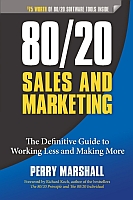The following are excerpts from my interview with Perry Marshall. You can enjoy more of my interview (as well as the complete mp3 audio download) where Perry talks about 80/20-Rule topics beyond sales and marketing, including time management, giftedness and living without regret. Read more and/or download the complete mp3 here
 Assume you're selling a $100 product and you get 100 people to buy it, generating $10,000 in sales ($100 x 100). You're feeling pretty good about yourself.
Assume you're selling a $100 product and you get 100 people to buy it, generating $10,000 in sales ($100 x 100). You're feeling pretty good about yourself.
But how much are these customers really worth? It's not $10,000.
According to Perry Marshall and his latest book, 80/20 Sales and Marketing: The Definitive Guide to Working Less and Making More (Entrepreneur Press, Aug. 13th), it's worth more than 2.5X that amount.
Perry spoke recently with me about his ten-year quest to understand and apply Pareto's (80/20) Principle to marketing, sales and life. Edited excerpts:
Explain how you get the 2.5X-factor in my "100 customers buying a $100 product" example.
The 80/20 Rule pretty much guarantees that of those 100 people, a fifth of them will spend four times the money and a fifth of them will spend four times that much money and a fifth of them will spend four times that much money, and so on.
Perry's 80/20 Math
100 people spend $100 each. Of these 100, 20% (or 20 people) will spend $400. An additional $300 per person.
Of the 20, 20% (4 people) will spend $1600... an additional $1,500 per person.
Of the 4, 20% (.8 people, which I will round up to 1) will spend $6,400... an additional $6,300.
80/20 shows you that almost any business leaves money on the table. If 1,000 people came to your restaurant once, you can figure out how many people will come to your restaurant everyday, order the most expensive thing on your menu or pay you to host their son's Bar Mitzvah. It's insanely predictable.
So the reason most businesses leave money on the table is that they haven't offered the right combination of products?
Right, they haven't been offered the right thing. For instance, consider a non-profit's donor list. The great majority of donors are taking the $5 offer, while some are taking the $100 offer and a small number are in at the $100,000 range. That's all working fine. But your $1,000 to $10,000 range is a complete bust. Obviously, you must be missing what these donors want.
So the point is to find the most responsive customers -- the people who want to buy more (and more often)?
Right. Sales is a dis-qualification process. And, boy, it took me so long to figure this out.
If I sort all my customers from top to bottom, most of them are going to be a complete waste of time. It's just insanely inefficient trying to work with all of them. But when you focus on the most productive [or responsive], it makes a sharp turn and all of a sudden, the level of interest is exponential.
And that's really the whole thing about 80/20 is, it's exponential. Everything in business that matters is in multiples of two or multiples of ten or multiples of 100. It becomes inexhaustible because when you take the resources away from the wasteful side of the equation and put them into the efficient side of the equation, you get exponentially more.
What is it that put you on this 80/20 journey?
If you go to graduate school, there are these Pareto charts, but I found them all really difficult. After all, it is Calculus. Besides the complexity, I could never find anywhere that used 80/20 the way I felt you needed to use it in sales.
So I started chipping away at it and I eventually came up with this other way to formulate Pareto so it could be readily applied to sales. That led to my 80/20 seminars, my 80/20 book [all 225 pages!] and the 80/20 curve app.
You had this Eureka! moment. What was that?
That was when I discovered that there's an 80/20 inside the 80/20 inside the 80/20. Like layers of an onion. It's an exponential curve that goes infinitely high. And it's basically the same shape whether you're talking about how much revenue the sales reps generated or how much the Chicago Bulls got paid [during the Jordan years] or whatever. It's the same formula.
What is the 80/20 Curve app? Is it just for predicting sales?
Actually I call it my "Invisible Money" Finder app. It comes with the book but everyone may use it free without registration at www.8020curve.com.
Simply, it lets you make forward-looking predictions.
For instance, you can say, "Alright, we got 100 people to buy the $100 product. How many are going to buy the $500 product?" And the app will tell you. And how many people would buy a $2,000 product? And it would tell you.
Or you read a statistic in the newspaper and it says five million people gave $5 or more to Barack Obama's election campaign. So you stick that in the tool it tells you how many people gave $100 and how many people gave $1,000.
More of my interview with Perry Marshall (and a complete audio download) is available here.
John Fox is the Founder and President of Venture Marketing, a B2B marketing consulting firm enabling sales reps to win more deals with disruptive, challenger marketing, compelling their customers and channel partners to re-examine how they do things and consider new alternatives. To talk with Venture Marketing and ask your B2B marketing questions, please contact us at Venture Marketing.
© 2013 John Fox. All Rights Reserved.
